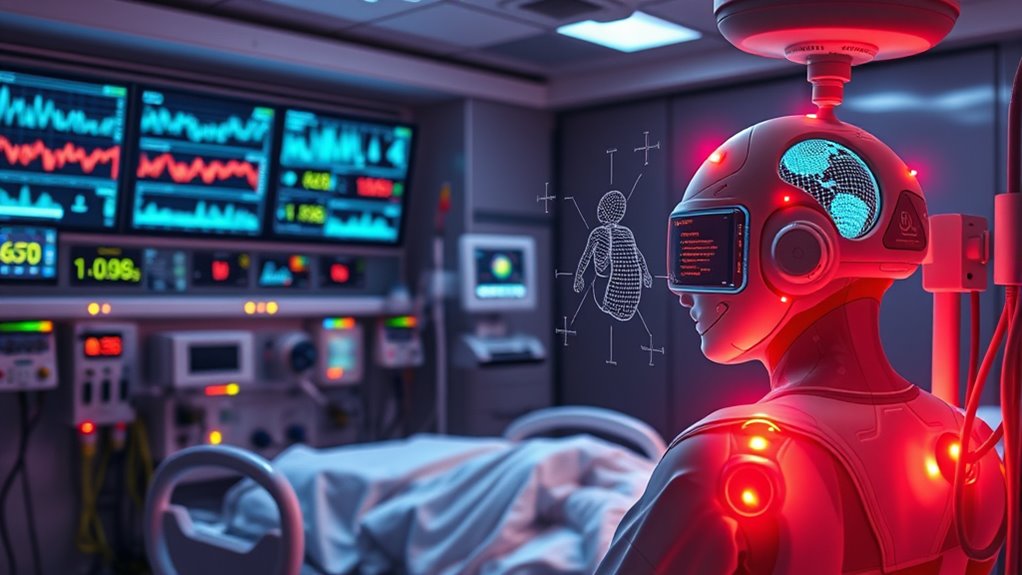AI systems for real-time sepsis detection analyze large amounts of electronic health data to identify subtle warning signs well before symptoms worsen. They monitor essential signs, lab results, and other clinical information continuously, providing early alerts to healthcare providers. This rapid, accurate detection helps you act sooner, improving patient outcomes. If you want to understand how these advanced tools work and their benefits, keep exploring the latest developments in AI-powered sepsis detection.
Key Takeaways
- AI analyzes electronic health records and vital signs continuously to identify early signs of sepsis in real time.
- Machine learning models provide timely alerts, detecting severe sepsis up to six hours before traditional methods.
- AI systems integrate seamlessly with healthcare workflows, enhancing clinician decision-making and communication.
- Continuous data evaluation improves prediction accuracy and reduces false alarms, increasing clinician trust.
- Ongoing research addresses data quality, validation, and regulatory standards to ensure safe, reliable AI-driven sepsis detection.

Have you ever wondered how artificial intelligence is transforming healthcare? One of the most promising areas is in the early detection of sepsis, a life-threatening condition caused by the body’s extreme response to infection. Sepsis can lead to tissue damage, organ failure, and death if not identified and treated promptly. With approximately 49 million people affected worldwide each year, the urgency of swift diagnosis cannot be overstated. However, detecting sepsis is challenging because its symptoms are nonspecific and often mimic other illnesses, making traditional detection methods insufficient. That’s where AI steps in, offering a way to identify sepsis hours before symptoms become severe, markedly improving treatment outcomes.
AI technologies use advanced algorithms trained on vast amounts of clinical data from electronic health records (EHR). Machine learning models analyze this data to recognize subtle patterns associated with early sepsis signs. Deep learning techniques further enhance detection accuracy by processing complex, high-dimensional data, enabling systems to identify risks that might escape human notice. Predictive analytics play an essential role by continuously evaluating patient data—such as vital signs and lab results—to generate real-time risk scores. These AI-powered systems work silently in the background, constantly monitoring patients and providing clinicians with early alerts when sepsis risk becomes high. This real-time monitoring allows healthcare providers to intervene sooner, often before the condition worsens. Additionally, ongoing research into AI security ensures these systems are robust against vulnerabilities, which is vital as reliance on AI in critical care increases. Moreover, advancements in data quality are critical for maintaining high prediction accuracy in diverse clinical settings. As AI systems become more sophisticated, they also facilitate personalized medicine, tailoring interventions to individual patient profiles for better outcomes.
Advanced AI algorithms analyze clinical data to detect early sepsis signs and provide real-time alerts for prompt intervention.
The performance of AI in sepsis detection has already exceeded traditional methods, with some systems achieving accuracy rates of 82%. They also markedly reduce false alarms, so clinicians can trust the alerts and act with confidence. Importantly, AI can detect severe sepsis up to six hours earlier than conventional approaches, giving healthcare teams a critical window to initiate treatment. By providing continuous, real-time data analysis, AI supports rapid decision-making, which is indispensable in managing sepsis effectively. As these systems learn from ongoing data inputs, they improve their predictions over time, becoming more reliable and precise.
Integration of AI with healthcare systems is seamless when connected with EHR platforms. AI algorithms alert nursing staff instantly when a patient’s risk level rises, enabling prompt action. This collaborative approach fosters better communication between nurses and physicians, ensuring that treatment plans are timely and effective. Furthermore, AI tools work tirelessly to surveil all patients, offering ongoing, systematic review without fatigue or oversight. Multiple studies focus on embedding AI into existing healthcare infrastructures, aiming for perfect sepsis management.
Despite its promise, AI faces challenges. High-quality, accurate data is essential for maintaining prediction reliability, and sepsis’s varied presentations make consistent detection difficult. Rigorous clinical validation is needed to confirm AI’s effectiveness across different patient populations. Regulatory frameworks are also evolving to ensure safe and ethical use of AI in healthcare, paving the way for broader adoption. While AI has made remarkable strides, overcoming these hurdles remains essential to fully realize its potential in saving lives through early sepsis detection.
Frequently Asked Questions
How Accurate Is AI in Predicting Sepsis Onset?
You wonder about AI’s accuracy in predicting sepsis. Some models, like Wang et al.’s, achieve high accuracy with an AUC of 0.91, but performance varies across models. Incorporating diverse clinical data and clinician feedback can improve results. However, early detection remains challenging due to complex symptoms and data limitations. Overall, AI can be quite accurate, especially with high-quality data and ongoing validation efforts.
What Are the Privacy Concerns With Real-Time Data?
Imagine your medical data as a delicate treasure chest—keeping it secure is crucial. You might worry about unauthorized access, cyber threats, and data breaches. Real-time data collection heightens these concerns, especially around privacy and consent. You expect your information to stay confidential and be protected by encryption and strict regulations like HIPAA. Building trust requires transparency, education, and robust security measures to guarantee your health data remains private and safe.
Can AI Detect Sepsis in All Patient Populations?
You might wonder if AI can detect sepsis in all patient populations. While AI models are trained on diverse data, they don’t detect sepsis perfectly for everyone. Accuracy varies due to nonspecific symptoms and data integration challenges. Although AI improves early detection, it still needs ongoing validation across different groups. So, it’s a promising tool, but it doesn’t guarantee seamless detection for every patient at all times.
How Does AI Integrate With Existing Hospital Systems?
You might think integrating new tech is like fitting a puzzle piece, but it’s more like weaving threads into a tapestry. AI syncs with hospital systems by connecting with Electronic Health Records, continuously analyzing patient data, and sending alerts through existing communication networks. This seamless integration enhances decision-making, supports clinicians, and streamlines workflows, all while working silently in the background, turning complex data into a clear picture of patient health.
What Are the Costs Associated With Implementing AI Solutions?
You’ll need to take into account various costs when implementing AI solutions. Development and licensing fees can be high, and you’ll face expenses upgrading hardware and software. Ongoing costs include training staff and maintaining the system. Plus, integrating AI with your existing healthcare infrastructure can be complex and costly. Don’t forget data security and regulatory compliance, which also add to overall expenses. Planning for these costs helps ensure a successful deployment.
Conclusion
By harnessing AI for real-time sepsis detection, you’re arming yourself with a powerful sentinel that never sleeps. It’s like having a vigilant guardian watching over patients’ essential signs around the clock, catching warning signs before they escalate. This technology acts as your first line of defense, turning data into lifesaving insights. Embrace AI’s potential, and you’ll be steering healthcare toward faster, more accurate responses—saving lives one heartbeat at a time.











